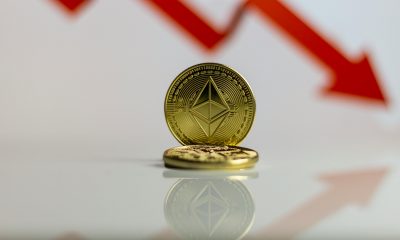

others
Gold turns sideways as markets hope for reduced Middle East tensions, – Crypto News
- Gold price dips from fresh highs near $2,430 as investors don’t see Middle East tensions escalating further.
- US bond yields soar as the Fed seems to initiate the rate cut cycle from September.
- The US Dollar exhibits strength on strong US Retail Sales data.
Gold price (XAU/USD) struggles for a firm footing near $2,350 in Monday’s early New York session after posting hefty losses on Friday. The precious metal loses shine in the very-short term as investors expect that geopolitical tensions will not escalate further. United States President Joe Biden said that his nation will not support the counterattack from Israel on Iran.
Receding Federal Reserve (Fed) rate cut bets for the June and July meetings, combined with less fears of further escalating Iran-Israel tensions, have put some pressure on Gold. Fed policymakers support keeping interest rates restrictive before they get convinced that inflation will return to the required rate of 2%
Meanwhile, stronger-than-expected monthly Retail Sales data for March has boosted bond yields and the US Dollar. The US Census Bureau reported that Retail Sales grew by 0.7%- the pace was more than double from expectations of 0.3%. In February, Retail Sales were up by 0.9%, upwardly revised from 0.6%. Robust spending by US households remains a major catalyst to higher inflation, allowing businesses to charge higher from consumers.
The 10-year US Treasury yields rally to 4.61%. Higher bond yields weigh on the Gold price as they increase the opportunity cost of holding an investment in it. The US Dollar Index (DXY), which tracks the US Dollar’s value against six major currencies, prints a fresh five-month high at 106.16.
Daily digest market movers: Gold price drops as investors see Middle East tensions stalling
- Gold price consolidates after retreating from fresh all-time highs near $2,430 as investors see Iran’s air strike on the Israeli state only as a retaliation to the attack on their embassy in Syria near Damascus. Tensions between Iran and Israel are not expected to escalate further as Tehran said, “the matter deemed to be closed.” However, should the Israeli regime make another mistake, Iran’s response will be considerably more severe, the Wall Street Journal reported.
- The statement from the United States that it will not support the counterattack from Israel has boosted confidence among investors that Middle East tensions will not escalate further. Over the weekend, Iran launched hundreds of drones and missiles aimed at Israel.
- Meanwhile, uncertainty over the Federal Reserve (Fed) pivoting to rate cuts has weighed heavily on Gold. Financial markets have shifted their expectations for Fed rate cuts to the September meeting as the United States Consumer Price Index (CPI) report turned out hotter than expected in March.
- San Francisco Fed Bank President Mary Daly said on Friday that there is no urgency to reduce interest rates. Daly added that there is still more work to do to ensure that inflation is on course to return to the desired rate of 2%. She also emphasised keeping interest rates restrictive as long as inflation is necessary to return to the 2% target.
- Separately, Boston Fed Bank President Susan Collins said she hopes demand will start slowing and will support bringing down inflation later this year. Collins said she forecasted two rate cuts in the latest dot plot, in which most Fed members projected the central bank reducing interest rates three times by year-end.
Technical Analysis: Gold slumps from fresh highs near $2,430
Gold price corrects from new all-time highs formed around $2,430. The precious metal faces pressure as momentum oscillators are overheated. The 14-period Relative Strength Index (RSI) drops slightly after peaking around 85.00. The near-term demand is intact as the RSI remains in the bullish range of 60.00-80.00. However, momentum oscillators are cooling down after turning extremely overbought.
On the downside, April 5 low near $2,268 and March 21 high at $2,223 will be major support areas for the Gold price.
Inflation FAQs
Inflation measures the rise in the price of a representative basket of goods and services. Headline inflation is usually expressed as a percentage change on a month-on-month (MoM) and year-on-year (YoY) basis. Core inflation excludes more volatile elements such as food and fuel which can fluctuate because of geopolitical and seasonal factors. Core inflation is the figure economists focus on and is the level targeted by central banks, which are mandated to keep inflation at a manageable level, usually around 2%.
The Consumer Price Index (CPI) measures the change in prices of a basket of goods and services over a period of time. It is usually expressed as a percentage change on a month-on-month (MoM) and year-on-year (YoY) basis. Core CPI is the figure targeted by central banks as it excludes volatile food and fuel inputs. When Core CPI rises above 2% it usually results in higher interest rates and vice versa when it falls below 2%. Since higher interest rates are positive for a currency, higher inflation usually results in a stronger currency. The opposite is true when inflation falls.
Although it may seem counter-intuitive, high inflation in a country pushes up the value of its currency and vice versa for lower inflation. This is because the central bank will normally raise interest rates to combat the higher inflation, which attract more global capital inflows from investors looking for a lucrative place to park their money.
Formerly, Gold was the asset investors turned to in times of high inflation because it preserved its value, and whilst investors will often still buy Gold for its safe-haven properties in times of extreme market turmoil, this is not the case most of the time. This is because when inflation is high, central banks will put up interest rates to combat it. Higher interest rates are negative for Gold because they increase the opportunity-cost of holding Gold vis-a-vis an interest-bearing asset or placing the money in a cash deposit account. On the flipside, lower inflation tends to be positive for Gold as it brings interest rates down, making the bright metal a more viable investment alternative.
-

 Blockchain24 hours ago
Blockchain24 hours agoOn-Chain Tokenization for Payments Professionals – Crypto News
-
Cryptocurrency6 days ago
Pi Community Highlights Pi Coin’s Slow Growth As ‘Strategic’ – Crypto News
-

 Cryptocurrency1 week ago
Cryptocurrency1 week agoProfessor Coin: What’s Driving Cryptocurrency Adoption Around the World – Crypto News
-

 Blockchain1 week ago
Blockchain1 week agoCZ claps back against ‘baseless’ US plea deal allegations – Crypto News
-

 Technology1 week ago
Technology1 week agoApple ramps up India production amid China uncertainty, assembles $22 billion worth iPhones in a year – Crypto News
-
Business5 days ago
Cardano (ADA) and Dogecoin (DOGE) Eye For Bullish Recovery – Crypto News
-

 Business5 days ago
Business5 days agoWorldpay and FIS Deals Echo 2019’s Payments Megamergers – Crypto News
-
![Shiba Inu [SHIB] price prediction - A 70% rally next after 900%+ burn rate hike?](https://dripp.zone/news/wp-content/uploads/2025/04/Shiba-Inu-SHIB-price-prediction-A-70-rally-next-400x240.png)
![Shiba Inu [SHIB] price prediction - A 70% rally next after 900%+ burn rate hike?](https://dripp.zone/news/wp-content/uploads/2025/04/Shiba-Inu-SHIB-price-prediction-A-70-rally-next-80x80.png) Cryptocurrency1 week ago
Cryptocurrency1 week agoShiba Inu [SHIB] price prediction – A 70% rally next after 900%+ burn rate hike? – Crypto News
-

 others1 week ago
others1 week agoGold consolidates near all-time peak as bulls pause for breather – Crypto News
-

 Cryptocurrency7 days ago
Cryptocurrency7 days agoWhite House Mulls Bitcoin Reserve Backed by Gold and Tariffs – Crypto News
-

 Cryptocurrency6 days ago
Cryptocurrency6 days agoOKX Returns to US Market Following $505M DOJ Deal – Crypto News
-

 Blockchain5 days ago
Blockchain5 days agoSolana Turns Bullish On 8H Chart – Break Above $147 Could Confirm New Trend – Crypto News
-
Technology4 days ago
Expert Predicts Pi Network Price Volatility After Shady Activity On Banxa – Crypto News
-

 Blockchain1 week ago
Blockchain1 week agoXRP Price To Hit $45? Here’s What Happens If It Mimics 2017 And 2021 Rallies – Crypto News
-

 others1 week ago
others1 week agoRipple Community Remains Disappointed With Hinman Report, What’s Next? – Crypto News
-

 Metaverse1 week ago
Metaverse1 week agoForget DeepSeek. Large language models are getting cheaper still – Crypto News
-

 others1 week ago
others1 week agoCrypto Strategist Sees Solana-Based Memecoin Surging Higher, Says One AI Altcoin Flashing Strong Chart – Crypto News
-

 Cryptocurrency1 week ago
Cryptocurrency1 week agoPepe is on the verge breakout to $0.0000078 as gold cross nears. – Crypto News
-

 Blockchain5 days ago
Blockchain5 days agoBitcoin online chatter flips bullish as price chops at $85K: Santiment – Crypto News
-

 Cryptocurrency5 days ago
Cryptocurrency5 days agoJudge Pauses 18-State Lawsuit Against SEC, Saying It Could ‘Potentially Be Resolved’ – Crypto News
-
Business5 days ago
Coinbase Reveals Efforts To Make Its Solana Infrastructure Faster, Here’s All – Crypto News
-

 Cryptocurrency1 week ago
Cryptocurrency1 week agoBitcoin – Here’s what’s next after sellers near exhaustion levels – Crypto News
-

 others1 week ago
others1 week agoOn-Chain Indicator Suggests Ethereum (ETH) Could Be Undervalued, According to Crypto Analyst – Crypto News
-

 others1 week ago
others1 week agoMexican Peso ends week strong as USD plunges on China tariff retaliation – Crypto News
-

 Blockchain1 week ago
Blockchain1 week agoOn-Chain Clues Suggest Bitcoin Bounce Might Be a False Signal—Here’s What to Know – Crypto News
-

 others1 week ago
others1 week agoChina’s Copper imports drop – ING – Crypto News
-

 Cryptocurrency6 days ago
Cryptocurrency6 days agoA decade in, Liberland needs the Bitcoin standard more than ever – Crypto News
-

 Technology6 days ago
Technology6 days agoIndia, Australia explore bilateral data-sharing treaty to tackle cybercrime – Crypto News
-

 Technology5 days ago
Technology5 days agoMoto Book 60 laptop, Pad 60 Pro launched in India: Price, features, battery and more – Crypto News
-

 others5 days ago
others5 days agoUnitedHealth stock caves 23% as it cuts full-year guidance – Crypto News
-
Technology5 days ago
Coinbase Reveals Efforts To Make Its Solana Infrastructure Faster, Here’s All – Crypto News
-
others5 days ago
Coinbase Reveals Efforts To Make Its Solana Infrastructure Faster, Here’s All – Crypto News
-
others5 days ago
How High Should Dogecoin Price Rise to Turn $10K to $100K? – Crypto News
-

 Technology1 week ago
Technology1 week agoPrice drop on 43 inch TVs: Grab the best deals on Samsung, Sony, Xiaomi and more, up to 57% off – Crypto News
-

 Technology1 week ago
Technology1 week ago3 Altcoins to Buy as US Senate Banking Chair Gives August Deadline For Major Crypto Bills – Crypto News
-

 Blockchain1 week ago
Blockchain1 week agoBoosting Ethereum: Bankless Cofounder Lays Out New Vision For Price Surge – Crypto News
-
![Bearish sequence in Nifty favors downside [Video]](https://dripp.zone/news/wp-content/uploads/2025/02/Bearish-sequence-in-Nifty-favors-downside-Video-Crypto-News-400x240.png)
![Bearish sequence in Nifty favors downside [Video]](https://dripp.zone/news/wp-content/uploads/2025/02/Bearish-sequence-in-Nifty-favors-downside-Video-Crypto-News-80x80.png) others1 week ago
others1 week agoDow Jones recovers ground to post one of its best weeks in years – Crypto News
-

 Cryptocurrency1 week ago
Cryptocurrency1 week agoScottish School Will Accept Bitcoin Payments, May Launch BTC Reserve – Crypto News
-

 Blockchain1 week ago
Blockchain1 week ago‘Bitcoin Standard’ author to develop Austrian economics curriculum for UK school – Crypto News
-

 Business1 week ago
Business1 week agoMichael Saylor Hints At Another MicroStrategy Bitcoin Purchase, BTC Price To Rally? – Crypto News
-

 others1 week ago
others1 week agoMantra Team Responds As The OM Token Price Crashes Over 80% In 24 Hours – Crypto News
-

 others1 week ago
others1 week agoUSD/CAD falls toward 1.3850 due to potential US recession, persistent inflation – Crypto News
-

 Blockchain1 week ago
Blockchain1 week agoCrypto markets ‘relatively orderly’ despite Trump tariff chaos: NYDIG – Crypto News
-

 others6 days ago
others6 days agoPresident Trump Planning Launch of New Monopoly-Inspired Crypto Game: Report – Crypto News
-

 Blockchain6 days ago
Blockchain6 days agoStablecoins’ dominance due to limitations of US banking — Jerald David – Crypto News
-

 Cryptocurrency6 days ago
Cryptocurrency6 days agoSOL remains bullish amid broader market stagnation – Crypto News
-

 Technology5 days ago
Technology5 days agoSpotify down: Music streaming giant leaves thousands of users affected globally – Crypto News
-
Business5 days ago
Crypto Whales Bag $20M In AAVE & UNI, Are DeFi Tokens Eyeing Price Rally? – Crypto News
-

 Blockchain5 days ago
Blockchain5 days agoJio partnership to drive real-world Web3 adoption for 450M users – Crypto News
-

 Metaverse5 days ago
Metaverse5 days agoLe Chat, the cat-bot France has pinned its AI hopes on – Crypto News










